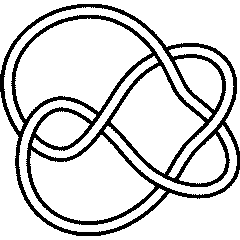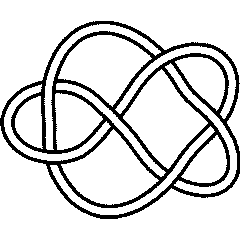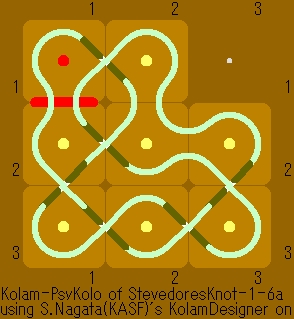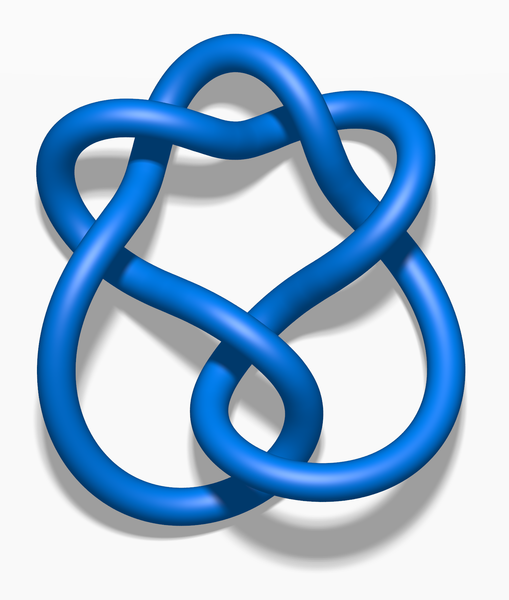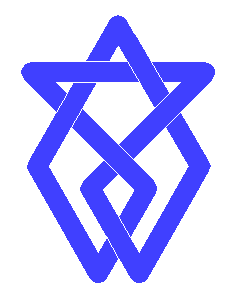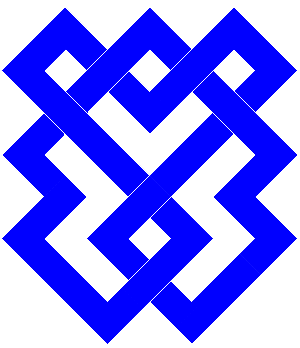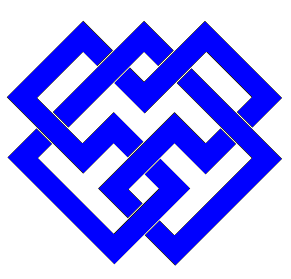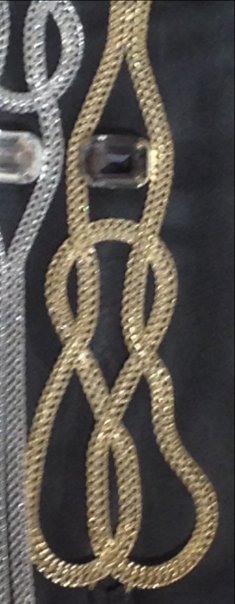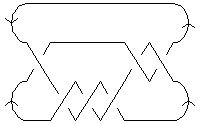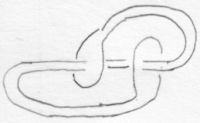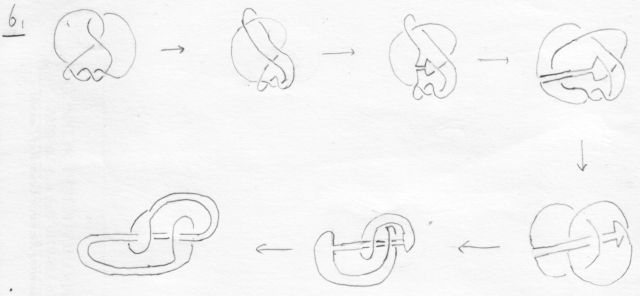6 1: Difference between revisions
DrorsRobot (talk | contribs) No edit summary |
DrorsRobot (talk | contribs) No edit summary |
||
| Line 41: | Line 41: | ||
{{4D Invariants}} |
{{4D Invariants}} |
||
{{Polynomial Invariants}} |
{{Polynomial Invariants}} |
||
== "Similar" Knots (within the Atlas) == |
|||
Same [[The Alexander-Conway Polynomial|Alexander/Conway Polynomial]]: |
|||
{[[9_46]], [[K11n67]], [[K11n97]], [[K11n139]], ...} |
|||
{{Vassiliev Invariants}} |
{{Vassiliev Invariants}} |
||
Revision as of 16:11, 29 August 2005
|
|
|
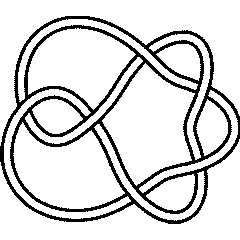
|
Visit 6 1's page at the Knot Server (KnotPlot driven, includes 3D interactive images!)
Visit 6 1's page at Knotilus! Visit 6 1's page at the original Knot Atlas! 6_1 is also known as "Stevedore's Knot" (see e.g. [1]), and as the pretzel knot P(5,-1,-1). |
Knot presentations
| Planar diagram presentation | X1425 X7,10,8,11 X3948 X9,3,10,2 X5,12,6,1 X11,6,12,7 |
| Gauss code | -1, 4, -3, 1, -5, 6, -2, 3, -4, 2, -6, 5 |
| Dowker-Thistlethwaite code | 4 8 12 10 2 6 |
| Conway Notation | [42] |
|
Length is 7, width is 4. Braid index is 4. |
Three dimensional invariants
|
[edit Notes for 6 1's three dimensional invariants]
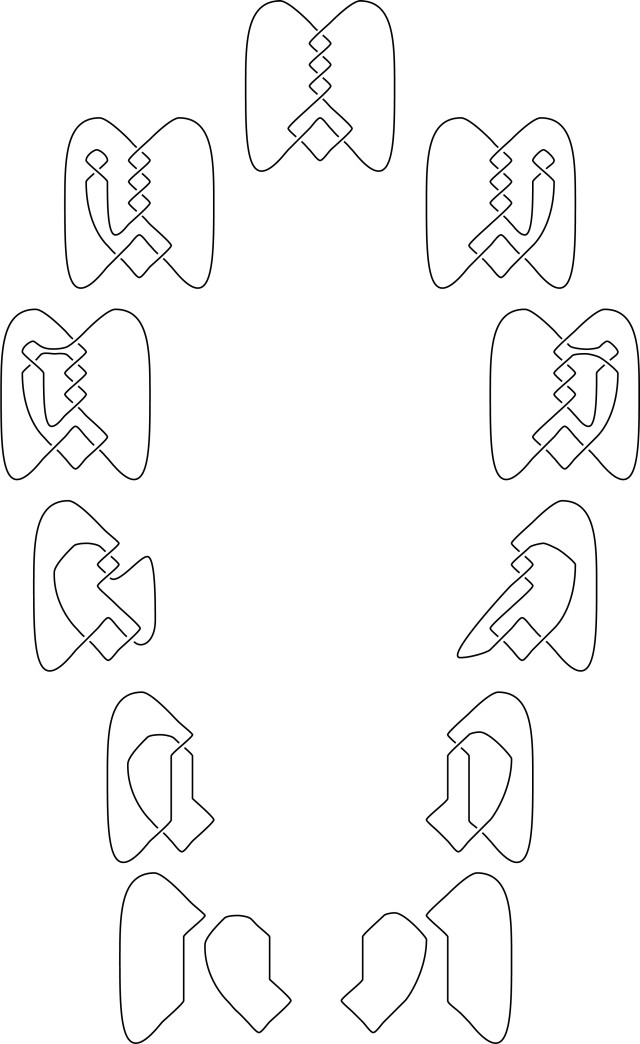 6_1 has two slice disks, by Scott Carter |
Four dimensional invariants
|
Polynomial invariants
A1 Invariants.
| Weight | Invariant |
|---|---|
| 1 | |
| 2 | |
| 3 | |
| 4 | |
| 5 | |
| 6 |
A2 Invariants.
| Weight | Invariant |
|---|---|
| 1,0 | |
| 1,1 | |
| 2,0 | |
| 3,0 |
A3 Invariants.
| Weight | Invariant |
|---|---|
| 0,1,0 | |
| 1,0,0 |
A4 Invariants.
| Weight | Invariant |
|---|---|
| 0,1,0,0 | |
| 1,0,0,0 |
B2 Invariants.
| Weight | Invariant |
|---|---|
| 0,1 | |
| 1,0 |
D4 Invariants.
| Weight | Invariant |
|---|---|
| 1,0,0,0 |
G2 Invariants.
| Weight | Invariant |
|---|---|
| 1,0 |
.
KnotTheory`, as shown in the (simulated) Mathematica session below. Your input (in red) is realistic; all else should have the same content as in a real mathematica session, but with different formatting. This Mathematica session is also available (albeit only for the knot 5_2) as the notebook PolynomialInvariantsSession.nb.
(The path below may be different on your system, and possibly also the KnotTheory` date)
In[1]:=
|
AppendTo[$Path, "C:/drorbn/projects/KAtlas/"];
<< KnotTheory`
|
Loading KnotTheory` version of August 31, 2006, 11:25:27.5625.
|
In[3]:=
|
K = Knot["6 1"];
|
In[4]:=
|
Alexander[K][t]
|
KnotTheory::loading: Loading precomputed data in PD4Knots`.
|
Out[4]=
|
In[5]:=
|
Conway[K][z]
|
Out[5]=
|
In[6]:=
|
Alexander[K, 2][t]
|
KnotTheory::credits: The program Alexander[K, r] to compute Alexander ideals was written by Jana Archibald at the University of Toronto in the summer of 2005.
|
Out[6]=
|
In[7]:=
|
{KnotDet[K], KnotSignature[K]}
|
Out[7]=
|
{ 9, 0 } |
In[8]:=
|
Jones[K][q]
|
KnotTheory::loading: Loading precomputed data in Jones4Knots`.
|
Out[8]=
|
In[9]:=
|
HOMFLYPT[K][a, z]
|
KnotTheory::credits: The HOMFLYPT program was written by Scott Morrison.
|
Out[9]=
|
In[10]:=
|
Kauffman[K][a, z]
|
KnotTheory::loading: Loading precomputed data in Kauffman4Knots`.
|
Out[10]=
|
"Similar" Knots (within the Atlas)
Same Alexander/Conway Polynomial: {9_46, K11n67, K11n97, K11n139, ...}
Vassiliev invariants
| V2 and V3: | (-2, 1) |
| V2,1 through V6,9: |
|
V2,1 through V6,9 were provided by Petr Dunin-Barkowski <barkovs@itep.ru>, Andrey Smirnov <asmirnov@itep.ru>, and Alexei Sleptsov <sleptsov@itep.ru> and uploaded on October 2010 by User:Drorbn. Note that they are normalized differently than V2 and V3.
Khovanov Homology
| The coefficients of the monomials are shown, along with their alternating sums (fixed , alternation over ). The squares with yellow highlighting are those on the "critical diagonals", where or , where 0 is the signature of 6 1. Nonzero entries off the critical diagonals (if any exist) are highlighted in red. |
|
| Integral Khovanov Homology
(db, data source) |
|
Computer Talk
Much of the above data can be recomputed by Mathematica using the package KnotTheory`. See A Sample KnotTheory` Session.
In[1]:= |
<< KnotTheory` |
Loading KnotTheory` (version of August 29, 2005, 15:27:48)... | |
In[2]:= | Crossings[Knot[6, 1]] |
Out[2]= | 6 |
In[3]:= | PD[Knot[6, 1]] |
Out[3]= | PD[X[1, 4, 2, 5], X[7, 10, 8, 11], X[3, 9, 4, 8], X[9, 3, 10, 2], X[5, 12, 6, 1], X[11, 6, 12, 7]] |
In[4]:= | GaussCode[Knot[6, 1]] |
Out[4]= | GaussCode[-1, 4, -3, 1, -5, 6, -2, 3, -4, 2, -6, 5] |
In[5]:= | BR[Knot[6, 1]] |
Out[5]= | BR[4, {-1, -1, -2, 1, 3, -2, 3}] |
In[6]:= | alex = Alexander[Knot[6, 1]][t] |
Out[6]= | 2 |
In[7]:= | Conway[Knot[6, 1]][z] |
Out[7]= | 2 1 - 2 z |
In[8]:= | Select[AllKnots[], (alex === Alexander[#][t])&] |
Out[8]= | {Knot[6, 1], Knot[9, 46], Knot[11, NonAlternating, 67],
Knot[11, NonAlternating, 97], Knot[11, NonAlternating, 139]} |
In[9]:= | {KnotDet[Knot[6, 1]], KnotSignature[Knot[6, 1]]} |
Out[9]= | {9, 0} |
In[10]:= | J=Jones[Knot[6, 1]][q] |
Out[10]= | -4 -3 -2 2 2 |
In[11]:= | Select[AllKnots[], (J === Jones[#][q] || (J /. q-> 1/q) === Jones[#][q])&] |
Out[11]= | {Knot[6, 1]} |
In[12]:= | A2Invariant[Knot[6, 1]][q] |
Out[12]= | -14 -12 -6 -4 2 6 8 q + q - q - q + q + q + q |
In[13]:= | Kauffman[Knot[6, 1]][a, z] |
Out[13]= | 2 3-2 2 4 3 z 2 2 4 2 z |
In[14]:= | {Vassiliev[2][Knot[6, 1]], Vassiliev[3][Knot[6, 1]]} |
Out[14]= | {-2, 1} |
In[15]:= | Kh[Knot[6, 1]][q, t] |
Out[15]= | 1 1 1 1 1 1 5 2 |
See/edit the Rolfsen_Splice_Template.
